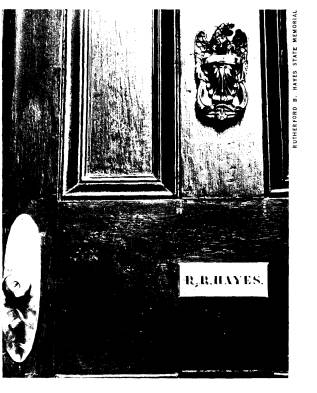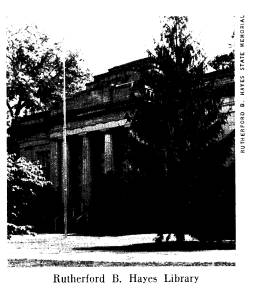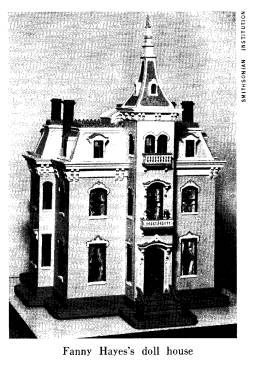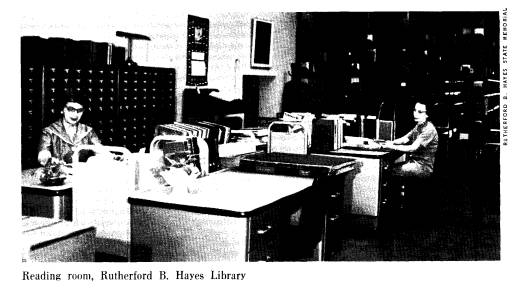Ohio History Journal
|
COLLECTIONS AND EXHIBITS COLLECTIONS OF THE RUTHERFORD B. HAYES STATE MEMORIAL |
|
|
ONE OF OHIO'S finest historical properties is the Rutherford B. Hayes State Memo- rial, located in Spiegel Grove, the twenty- five-acre home estate of the nation's nine- teenth president at Fremont. Administered jointly by the Ohio Historical Society and the Rutherford B. Hayes and Lucy Webb Hayes Foundation, this public memorial includes the stately Victorian brick mansion of the president and his family; the graves of Mr. and Mrs. Hayes, marked by a monument of Ver- mont granite; and the Rutherford B. Hayes Library, an Ohio sandstone struc- ture which houses the personal papers and library of President Hayes, the pa- pers of members of his family, a library and research center devoted primarily to the history of the United States from |
|
by WATT P. MARCHMAN and JAMES H. RODABAUGH 1860 to the end of the nineteenth century, and a museum which emphasizes the life of the president. Spiegel Grove became public property in 1910, when it was given by the presi- dent's children, through a son, Colonel Webb C. Hayes, to the state of Ohio. In return for the gift the state promised to erect a fireproof building to house the president's papers, library, and memo- rabilia. The building and its contents were to be open free to the public for- ever. The structure was completed in 1916, and a second and larger building, paid for by Colonel Hayes, was added to it in 1922. The museum rooms contain hundreds of items that belonged to President and Mrs. Hayes. There the visitor may see |
|
152 OHIO HISTORY |
|
the dress Mrs. Hayes wore at her wed- ding in 1852, as well as several of her gowns when she was the nation's first lady. President Hayes is represented in part by displays of equipment he wore or used during his service as major, lieu- tenant colonel, colonel, brigadier general, and brevet major general in the Civil War, including uniforms, swords, revol- vers, holsters, field glass, mess kit, saddle, saddle bags, bridle and bit, bed roll, camp chest, field officer's desk, and regi- mental flags. Among the things associated with the presidency are a landau made by the Brewster Company of New York, carriage manufacturers, and purchased by the president in March 1877, a walnut, roll-top, high desk and chair and a wal- nut, marble-top water table, both of which were purchased by Lincoln and used in the second-floor cabinet room in the White House until Theodore Roosevelt redecorated, and a piano which was given to the president by the Bradbury Piano Company. Another notable item from the presidential period is a three-story doll house, which was exhibited at a fair in Baltimore and then presented to Fanny Hayes, the president's only daughter, when she was ten years old. There are also pieces of the Hayes White House china, made by Haviland and Company in Limoges, France, and decorated in an American flora and fauna pattern by an American artist, Theodore R. Davis. Also associated with Mr. and Mrs. Hayes are a number of family portraits and numerous photographs. Other inter- esting family items include the grand- father's clock purchased by Rutherford Hayes, the president's father, at the time of his marriage to Sophia Birchard, the president's mother, in Vermont in 1812. There are two old flintlock rifles which were used in the War of 1812, one by Rutherford Hayes, the other by James Webb, Mrs. Hayes's father, of Lexington, |
|
|
Kentucky. The latest addition to the mu- seum exhibits is the jewelry that belonged to the president and his wife, which was discovered recently in a vault in a Fre- mont bank. The second principal collection in the museum is that of Colonel Webb C. |
|
|
|
COLLECTIONS AND EXHIBITS 153 |
|
Hayes. Webb began his collecting hobby as a young man, when, on a number of hunting trips in the Rocky Mountains with his godfather, Major General George Crook, he brought together a collection of hunting and Indian relics. Among the pieces of hunting equipment are three guns given Webb by General Crook, a very rare Sharps rifle with the mono- gram "G.C.," a Winchester rifle with a telescopic sight especially mounted for Crook, and a fine Marlin repeating rifle, all of which were used by Crook on the Rocky Mountain frontier. Webb's big collecting efforts, however, were con- nected with his military service during and after the Spanish-American War. In 1898 he served in Cuba and Puerto Rico as a major of the First Ohio Cavalry, returning with a quantity of curios of the war. Shortly after his return from Cuba, he sailed for the Philippines, where he served as a lieutenant colonel of the Thirty-First United States Volunteer In- fantry Regiment in putting down the Philippine Insurrection and received the Congressional Medal of Honor for gal- lantry in the campaign against the Moros on Mindanao. From the Philippines he sailed to China as a member of Major General Adna R. Chaffee's staff in the China Relief Expedition against the Boxer Rebellion in 1900, and several years later he was an observer in the Russo-Japanese War, at one point with the Japanese army on its march through Korea to the Yalu River, and at another time with the Rus- sian army near Mukden. In the Philippines and in China, Webb made a special effort to add to his and his father's growing collections, especially of Oriental weapons. Now, to the presi- dent's collection of antique Japanese swords and knives, some of which are jewel-encrusted, Webb added numerous pieces. Among them was a cannon used first in the Manchu conquest of China in |
|
the early seventeenth century and finally captured from the Boxers as they were attacking the foreign legations in Peking. Another piece, a single-barreled Spanish lantaca, or culverin, from the royal barge of the sultan of Mindanao, was a present from the sultan, who also offered Lieu- tenant Colonel Hayes ten of his three hundred Moro wives. Along with the collection of Oriental and Spanish weapons, the museum con- tains a small but valuable group of other guns. Several, representing the first four wars in the nation's history, are of par- ticular interest. One is a bronze cannon inscribed with the British coat of arms and the royal ciphers of the kings of England and France, and marked "R. Gilpin Fecit 1761." It was captured near Saratoga, October 7, 1777, by Benedict Arnold. His name was in the inscription recording its capture placed on the can- non at Arnold's order, but apparently was removed after he was found guilty of treason. Another is a British coehorn taken during the War of 1812. A third is a bronze cannon, inscribed "San Juan," which was captured during the Mexican War. It was one of four guns known as the Apostles' Battery, or the Four Apostles, which were given to Cor- tez by the Spanish sovereigns and used in the conquest of Mexico. The fourth is a brass six-pound gun, inscribed "Louisiana," captured by Union forces during the Civil War. In addition to these materials, there are collections of relics of the Civil War and World War I, of things associated with Lincoln, including his slippers, a pair of his gloves, and a handbill of the perform- ance at Ford Theater on the night of the assassination, of political badges dating back to the campaign of 1840, and many other items. Letters bearing the signa- tures of all of the presidents of the United States are also on display. |
|
154 OHIO HISTORY |
|
More significant than the museum ma- terials, however, are the library collec- tions, which have grown through the years and have transformed the Hayes State Memorial into an important re search center in American history. With three-quarters of a million manuscripts, over sixty-five thousand volumes, hun- dreds of scrapbooks, many thousands of pamphlets, booklets, periodicals, and newspapers, well over fifty thousand photographs and pictures, a sizeable group of maps, and a considerable col- lection of microfilm, the Rutherford B. Hayes Library has become a notable source of primary information on Presi- dent Hayes and his administration, the Civil War, reconstruction following that war, civil service reform, monetary re- form, prison reform, education, especially in the South, the history of the Negro, the Spanish-American War, and the his- tory of the Sandusky Valley in Ohio. The president's personal library of over ten thousand volumes and a quantity of ephemera, contains valuable materials for the serious student of the West, In- dians, American literature and biography, and the literature of travel in America. Another distinguished collection of books consists of over four hundred volumes of first editions and variation copies of the writings of William Dean Howells. The principal manuscript collection in the library is that of the personal papers of Rutherford B. Hayes, ranging from 1834 to the time of his death in 1893, which constitutes one of the nation's most important sources on the history of the United States in the latter half of the nineteenth century. The chief groups among the papers are Hayes's diary of 34 volumes, which he started in 1834 and continued throughout his life; 5,000 let- ters and drafts written by Hayes; 60,000 letters received; messages and speeches, consisting of 2,500 pieces; Civil War |
|
papers; and about 300 volumes of letter- books, notebooks, appointment records, scrapbooks, and newspaper clipping books. The library continues a constant search for original R. B. Hayes letters and has added also photographic copies of Hayes letters in the papers of many of his correspondents located in libraries throughout the country. A second valuable group of manu- scripts is made up of the Hayes family papers. Among these are the correspond- ence and other papers of Lucy Webb Hayes, the president's wife (7,500 pieces); the correspondence, diaries and journals, and miscellaneous notes of So- phia Hayes, his mother (215 pieces and 6 volumes); the diaries and journals of Chloe Smith Hayes, his grandmother (4 volumes, 1821-42); and the papers, total- ing more than 4,000 pieces, of Sardis Birchard, a Fremont merchant and banker, and Hayes's uncle. There are pa- pers of Hayes's sons and daughter-- Birchard A., Rutherford P., Scott R., Webb C., and Fanny--and the diaries, journals, and papers of Mary Miller Hayes, Webb's wife (8 volumes, and many thousands of pieces of correspond- ence.) The papers of Colonel Webb C. Hayes are the most numerous and com- plete and reflect his business interests and those of his father, and his service in the Spanish-American War and World War I. In this collection are twenty thou- sand pieces of correspondence and other papers, 1862-1934, four volumes and a hundred and fifty pieces of military pa- pers, 1898-1902, thirteen volumes of ac- count and note books, four volumes of diaries and notebooks kept while Webb was in school in Columbus, 1871-74, seven volumes of diaries and journals of the presidential period, three volumes of diaries and journals kept on his jaunts to the Philippines and China, 1899-1900, and three volumes of diaries and journals |
|
COLLECTIONS AND EXHIBITS 155 |
|
of travel in various parts of the world, 1900-1909. The diaries and journals of Colonel Webb Hayes and his wife are of great interest and have seen little use. Among them is the colonel's account of his fan- tastic voyage to the Philippines in 1899 with a body of troops under his com- mand. Assigned to the British ship Manauense, he
was quarantined in port for some time when a contagious disease broke out aboard. Once afloat, the ship turned out to be a leaky old tub and water in the hold wrecked the electrical system and destroyed food supplies. Webb Hayes was finally forced to seize command of the ship to keep it afloat. The calm Pacific turned on him too and churned up a typhoon in which the Man- auense was
lost from its convoy. Among Mary Miller Hayes's diaries is an account of the Hayeses' reaction to the outbreak of World War I. On a trip to Cleveland when war was announced, they called back to Fremont to order that their bags be packed and a quantity of gold money be gotten from the bank for them. They returned to Fremont quickly, and immediately set out for England--without passports. Their arri- val in London in brilliant moonlight prompted them to order a car and take a midnight ride through the city instead of going to bed. They were soon on their way to Paris and their good friend Am- bassador Myron T. Herrick. Webb was determined to see the war. He managed transportation through "No Man's Land" to Brussels, where he had old friends in Ambassador Brand Whitlock and the German commandant, who had lived in Cleveland for a time. With the comman- dant's help, he traveled to Berlin and back to Brussels, and eventually met Mrs. Hayes and sailed for home. Other groups of papers in the library include a quantity on the Civil War, |
|
among them rosters, muster rolls, lists of casualties, records of officers, orders, and letters of the Twenty-Third, Forty-Ninth, and Seventy-Second Ohio Volunteer In- fantry regiments, recollections of the Twenty-Third O.V.I. by James M. Comly, Russell Hastings, and an unnamed au- thor, the diaries of Colonel F. W. Swift, the letters of General B. F. Coates, a letterbook containing over 500 letters plus 75 photographs of military installa- tions which belonged to General Henry W. Benham, and records of Sandusky County men in the conflict. There are 750 pieces of White House correspondence of presidents who pre- ceded Hayes between 1860 and 1875. In addition there are other papers of a number of men who served as president or vice president, including James Bu- chanan (14), Abraham Lincoln (180), Andrew Johnson (158), Ulysses S. Grant (255), James A. Garfield (30), Chester A. Arthur
(16), Benjamin Harrison (42), and Schuyler Colfax (34). Seven "diaries" for the daily information of the president, kept by Benjamin Frank- lin Montgomery, White House telegrapher under McKinley and Roosevelt (1898- 1902), are also in the collections. They contain important messages sent and re- ceived concerning the Spanish-American War, the Philippine Insurrection, and the Boxer Rebellion. The largest single manuscript collec- tion obtained since the direction of the library passed from Colonel Hayes's hands early in the thirties, is the corre- spondence and business papers of Arthur L. Conger, a resident of Akron who was a prominent manufacturer and chairman of the Republican state committee and a member of the Republican national com- mittee in the 1880's. Its more than fifteen thousand pieces and fifteen volumes con- stitute a valuable source on the political history of Ohio and the nation in the |
|
156 OHIO HISTORY |
|
1880's and 1890's, as well as on the his- tory of the industrial development that accompanied the gas boom in Ohio and Indiana. Conger had a wide correspond- ence with such notable figures as Russell A. Alger of Michigan, James G. Blaine, Charles W. Fairbanks of Indiana, Ohio governors Charles Foster (1880-84) Jo- seph B. Foraker (1886-90), and Asa H. Bushnell (1896-1900), Murat Halstead, Cincinnati newspaper publisher, Ben- jamin Harrison, Congressman J. Warren Keifer of Springfield, Ohio, who was speaker of the United States House of Representatives, 1881-83, Charles L. Kurtz of Columbus, one of Foraker's chief lieutenants, Cyrus H. McCormick, William
McKinley, and Senator Henry C. Payne of Ohio. Other manuscript collections include those of William K. Rogers of Columbus, Ohio, and Duluth, Minnesota, who was a personal friend and early law partner of Hayes, served as his private secretary during the presidency, and joined Hayes in land development in the Duluth area (3,018 pieces); Robinson Locke, editor of the Toledo Blade (among these papers are a number of Petroleum V. Nasby items by Locke's father, David Ross Locke) (3,000
pieces); William and Mary Buckland Davenport Claflin, gov- ernor of Massachusetts and United States Congressman and author respectively (8,500 pieces); Benson J. Lossing, jour- nalist and historian (several thousand pieces); Stanley Matthews, United States Senator from Ohio, justice of the United States Supreme Court, and warm friend of R. B. Hayes (several thousand pieces); William Dean Howells (323 pieces); George William Curtis, author and edi- tor of Harper's Weekly (279 pieces); Benjamin H. Bristow, solicitor general and secretary of the treasury under Grant (182 pieces); Mary Clemmer Ames, nov- elist of Utica, New York (145 pieces); |
|
Charles O'Neill, a naval officer from Massachusetts (408 pieces for the years 1895-99); General Jay J. Morrow, an officer in the campaign against the Philip- pines in 1899; Henry Ward Beecher (187 pieces); Harriet Beecher Stowe (68 pieces); and John G. Whittier (81 pieces). There are also letterbooks (1841-45) of Andrew E. Douglass, an astronomer who is best known for his studies of the use of tree rings in establishing the dates of prehistoric sites; the diaries (1857- 1914) of William A. Hart, "an ordinary citizen of Connecticut," a farmer, and a Democrat; and two official letterbooks of Major General George Crook for the years 1871-90. Finally, among the manuscript mate- rials are a number of items concerning Fremont and the area around it. There are some papers of Thomas L. Hawkins pertaining to his business interests and to the establishment of Croghansville, the early village located on the east side of the Sandusky River, which, with Lower Sandusky on the west side, later became Fremont. There is also a collection of papers of John R. Pease, a Fremont mer- chant with whom Hayes lived when he set up his law practice in 1845-47. Three important personal collections of Fremont citizens of the nineteenth century are those of Dr. James Wilson (1,350 pieces), Dr. John B. Rice, who served in the United States House of Representatives (1,800 pieces), and Colonel William E. Haynes, who was a leading merchant and banker as well as a congressman (1,200 pieces). The Lucy Elliot Keeler collec- tion of over 1,000 letters and other pa- pers, 14 volumes of diaries, and 66 vol- umes of notes and memoranda, covering the period from 1885 to 1925, is a valu- able source of local history. While adding to its manuscript files, the Hayes Library has been expanding its |
|
COLLECTIONS AND EXHIBITS 157 |
|
|
|
microfilm collections, including copies of papers of many of Hayes's contemporaries and the important newspapers of the pe- riod which are located in other libraries or in private hands. Included among the personal papers microfilmed are those of William Henry Smith, one of Hayes's closest friends and general manager of the Associated Press; W. D. Bickham, for many years editor of the Dayton Journal and a leader in the campaign to nominate Hayes in 1876; Carl Schurz, who became Hayes's secretary of the in- terior; James A. Garfield; Benjamin H. Bristow; William E. Chandler; Samuel J. Tilden; Samuel Sullivan ("Sunset") Cox; Senator John A. Bingham; Salmon P. Chase; William Dean Howells; and James M. Comly, editor of the Ohio State Journal. In connection with Hayes's in- terest in education in the South and his work on the Slater and Peabody funds, papers of Jabez Lamar Monroe Curry, agent for the Slater Fund, and Daniel Coit Gilman, president of Johns Hopkins University, have been microfilmed, along with selections from the Peabody Fund Papers at the George Peabody College for Teachers, Nashville, and the Slater |
|
Fund Papers in the Southern Education Foundation, Inc., Washington, D. C. The library is also gradually acquiring copies of the government records created by the Hayes administration in Washington. The Rutherford B. Hayes Library was the first presidential library to be estab- lished as a research center on the home grounds or in the home town of a presi- dent. It became the model which was fol- lowed in the establishment of the Franklin D. Roosevelt Library at Hyde Park, New York, which in turn led to the erection of the Harry S. Truman Library in Inde- pendence, Missouri, the Dwight D. Eisen- hower Library in Abilene, Kansas, and the Herbert Hoover Library in West Branch, Iowa. The Hayes Library, how- ever, is the only one to be maintained and operated by the native state of the president it honors. THE AUTHORS: Watt P. Marchman has been director of research of the Hayes State Me- morial since 1946. James H. Rodabaugh, editor of Ohio History, was assistant director of re- search from 1940 to 1944. |



